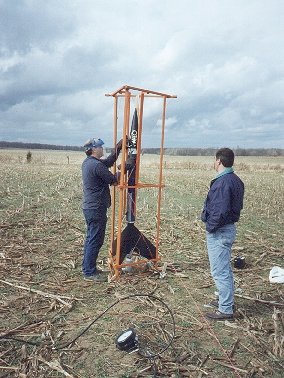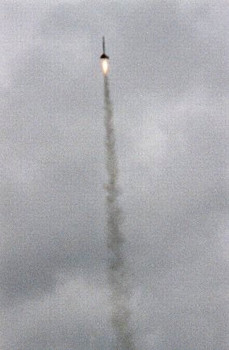Project HALO (High-Altitude Lift-Off): GL-1
Taking the First Step into Space or Making a Rocket Powered Fence Post Hole Digger?
Held on Saturday, April 13, 1996 at the Barrens Test Range in Manchester, Tennessee
The following text was taken, with permission, from an article by
by Gregory Allison, which was published in the
May-June 1996 issue of the Southeastern Space Supporter, newsletter of HAL5.
Who said 13 was an unlucky number? There we stood in a windswept
cornfield near Manchester, Tennessee on Saturday, the 13th of
April, with the HALO rocket stowed in its launch gondola in the
back of Al Wright's pickup truck. Wind gusts were so bad that
the local volunteer fire department, which was running a barbecue
concession for the event had to take down their canopy. Then,
a heavy rainstorm swept in followed by more wind. The wind was
almost steady with a few breaks of just four or five minutes.
Our launch window was only open from 2 to 4 pm. Launch conditions
did not appear to be optimal.
Woeful Weather
We feared that any gust of wind catching our oversized fins (designed
for a one percent atmosphere) would pitch our rocket horizontal
to the horizon converting it into an unguided ground strafing
cruise missile! Well of course that wouldn't do!
What to do?!? As it approached the time we would have to initiate
setup, I polled all the HALO experts. With hands stuffed into
pockets and feet kicking at the dirt and cornstalks I got the
resounding response: silence. Tim Pickens, anxious about the weather,
looked at me and said, "You guys (HAL5 Executive Committee,
I suppose?) tell me what to do, it's your decision", or something
like that. I looked across the field into the faces of all our
members present and thought of all the work they had done and
sacrifice they had made for this day.
To quit now would have crushed all their spirits. I knew we owed
it to them to at least try to set for launch and hope for a miracle
break in the weather. I looked at Tim and uttered the mundane
response, "No Guts -- No Glory! Let us at least set up and
then we'll see what happens."

Race Against Time -- and Rain
The rain had stopped so everyone cheerfully pitched in to initiate
setup. We pulled the plastic off the rocket/gondola launch system
and transported it to our designated launch area. (Launch site
director, Rick Kauffman had specified a separate launch site for
us so that other groups could continue launch activities with
little regard to our schedule.) We took a few photographs with
the rocket and proceeded to integrate the avionics. We discovered
a connector problem and discovered we had to drill an additional
hole. Time was ticking and the launch window was eroding. The
avionics were integrated, the rocket reinstalled into the gondola
(launch tube) the system was erected and staked down. Then -- more rain!
We rushed to cover the rocket with a plastic tarp while Al Wright
and Tim Pickens prepared to load the liquid nitrous oxide oxidizer.
There we all stood, in the rain, working and preparing for the
dubious chance that we might actually fly this bird. Loading was
proceeding slowly and the launch window was ticking down. I commandeered
Clay Sawyer's car (which was at our launch site) and went to Rick
Kauffman to plead for ten extra minutes. As it turned out he had
30 minutes of reserve, keeping our window open until 4:30 pm.
A few minutes before 4:00 pm, as the nitrous oxide loading was
nearing completion, the clouds broke and our spirits lifted.
Frozen Valve Frost Over Nose Cone
Tim Pickens and Al Wright, who had been loading the nitrous oxide
attempted to close the gaseous vent valve. In order to maximize
liquid oxidizer content in the tanks a gaseous vent valve is necessary
to get rid of gaseous phase oxidizer. Unfortunately, due to the
expansion of the exiting gasses there was an ice build up on the
valve and several adjacent components. Tim and Al each struggled
with two laborious attempts to close the valve -- no success.
Meanwhile, supercold leaking nitrous gas caused the bottom three
inches of the nose cone to frost over. Al and Tim both recommended
we scrub the flight.
Once again I looked around the field into all those now distant
faces bearing great expectations. It was as if something deep
inside told me was to fly that day. "Tim", I said, "try
it just one more time." With a look of total determination
on his face, a picture forever locked into my mind, Tim once more
set himself upon the task. I said a little prayer. The valve began
to move -- it closed! AT LAST! The hook-ups were removed and we
all walked or drove quickly to our launch positions.
Mysterious Electrical Problems
4:05 pm. The wind and rain had finally stopped. A big round patch
of beautiful blue sky hovered over us, as if sent by God. I handed
the fire control box to Al Wright. A large passenger jet flew
overhead. Though we had a high altitude launch window from the
FAA we were instructed to watch for aircraft and to not fly into
clouds that could block visibility of such aircraft. The plane
passed over. Al switched the safety shunt off, counted down and
threw the fire switch -- nothing happened. We all waited spellbound
-- long enough to permit a cook-off of the igniter. Again -- nothing.
Amazed, we switched the safety shunt back on.
Drew Prentice, president of Hybridine Aerospace Corporation (and
HAL5 member from Georgia) was first to reach the HALO rocket.
Tim Pickens, Al Wright, and I were close behind. We all fully
understood that we were approaching a potential hot bomb that
we might never walk away from. The operative word was "mission".
At that moment that was all that counted.
Battery leads were tightened, voltage checks were made. It seemed
we had isolated the problem. Once again we hurried to our launch
positions.
I took the launch control box. Another large passenger jet had
just passed overhead. I threw the safety shunt switch off, counted
down and threw the fire switch -- nothing happened, again! We
all stood in amazed silence. How could this be? I wondered if
the switches were cross wired (they were not). I began to toggle
the firing switch and the safety shunt switch alternately to see
what would happen.
The Rocket Launches!

I looked up at the rocket as my hopes were falling through my
chest, when suddenly -- WHOOSH! -- the rocket SCREAMED skyward!
We saw it cavort a bit, shed a few black objects which we assumed
were fins, spin stabilize, and climb straight into the sky! It
disappeared in less than 20 seconds. The launch time? 4:13 pm!
Who said 13 was an unlucky number?
It looks like our HALO rocket flew over 30,000 feet. Performance
exceeded expectations! The basic message that comes across to
me is that greatness lies at the ragged edge of the undoable.
When it can' be done -- you just have to push through it! Ad
Astra!
